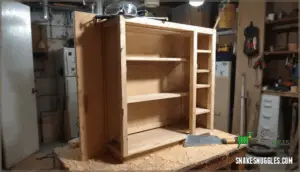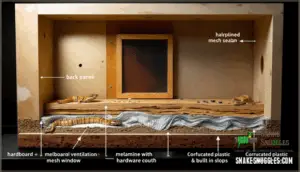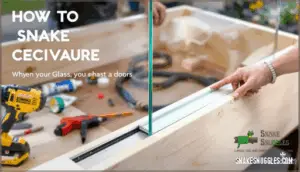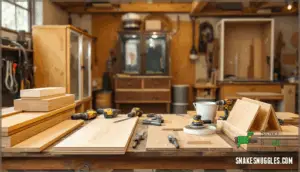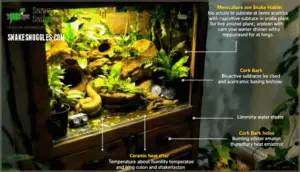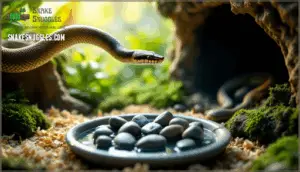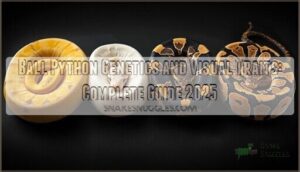This site is supported by our readers. We may earn a commission, at no cost to you, if you purchase through links.

Creating a snake habitat isn’t about replicating a pet store display; it’s about engineering a microclimate that matches your snake’s evolutionary adaptations, from substrate depth for burrowers to climbing structures for arboreal species.
Whether you’re converting a cabinet or building from scratch, success depends on understanding thermoregulation, humidity requirements, and behavioral enrichment before you bring your snake home.
Table Of Contents
Key Takeaways
- Snake habitat success hinges on engineering species-specific microclimates—temperature gradients, humidity levels, and substrate depth must match your snake’s evolutionary adaptations, as generic setups lead to feeding suppression, respiratory infections, and chronic stress within weeks.
- Converting used cabinets ($20–$100) into functional enclosures requires strategic modifications—removing solid back panels for ventilation, installing glass or acrylic doors with silicone sealing, and using non-toxic materials like hardboard or melamine to prevent off-gassing while maintaining structural integrity.
- Environmental control systems aren’t optional—thermostats prevent fatal overheating, digital monitoring tools track real-time conditions, and species-specific adjustments (tropical snakes need 60–80% humidity versus desert species’ minimal moisture) directly determine whether your snake feeds, sheds cleanly, and thrives behaviorally.
- Behavioral enrichment through climbing structures, tactile boards, puzzle feeders, and rotated décor prevents captive monotony while strengthening muscle mass and cognitive function—static enclosures breed stress and lethargy regardless of proper temperature and humidity.
Planning Your Snake Habitat Project
Before you start building, you’ll need to make some smart decisions about your setup. The choices you make now—from which snake species fits your lifestyle to how much space and money you can invest—will shape everything that comes after.
Every choice you make now—species, space, budget—shapes everything that follows in your snake habitat project
Let’s walk through the key planning steps that’ll set you up for success.
Choosing The Right Snake Species
Selecting the right snake species is where your habitat project begins. Your experience level matters tremendously—beginners thrive with forgiving species, while experienced keepers can manage more demanding requirements.
Consider these factors when choosing your snake:
- Beginner Snake Species like corn snakes and ball pythons offer predictable temperament and manageable care
- Temperament Considerations vary widely; some species are docile while others remain defensive
- Size Requirements range from small king snakes to large boa constrictors, directly affecting enclosure dimensions
- Dietary Needs differ across species, from small prey to larger meals, influencing feeding schedules and costs
Start by honestly evaluating your experience. Beginner pets like corn snakes are low-maintenance and easy to care for. Research species-specific behaviors, legal restrictions in your area, and whether you can commit to their lifespan. This groundwork helps your snake thrive and your project succeed.
Assessing Space and Budget Needs
Once you’ve locked in your snake species, the real constraints come down to two practical questions: how much space can you dedicate, and what’s your realistic budget?
Space availability determines your enclosure size. Snakes need room to move—research recommends minimum dimensions of at least one snake length across all three linear axes. A corn snake requires different space than a boa constrictor, so your species choice directly shapes your cabinet’s footprint.
Budget breaks down into three categories. Initial setup includes the cabinet itself (often $20–$100 from classifieds), materials for conversion, and furnishings. Heating needs—under-tank heaters, thermostats, temperature guns—usually run $50–$150. Long-term expenses cover substrate replacements, food, and occasional repairs. Factor these costs realistically before committing to your DIY snake cage project.
Sourcing Cabinets and Materials
Finding the right cabinet is half the battle, and the good news is that quality used cabinets are everywhere if you know where to look. Check local classifieds, Facebook Marketplace, and salvage options like estate sales—you’ll find decent cabinets for $20–$100.
Prioritize cabinet dimensions that match your snake’s length requirements across all three axes. Inspect materials carefully; avoid anything treated with toxic finishes or adhesives that could off-gas and harm your animal.
When comparing cost, factor in conversion materials: plywood for back panels, glass or acrylic doors, and hardware. Metal cabinets work well because they’re durable and won’t absorb moisture during enclosure construction.
Safety Precautions Before Starting
Before you grab that hand saw and start tearing into your cabinet, take a step back and protect yourself—because working with older materials and power tools demands respect and preparation. Wear safety glasses, gloves, and a dust mask to shield against debris and potential off-gassing from old finishes. Assure proper ventilation in your workspace. Keep a first aid kit nearby for minor cuts or scrapes.
Once your enclosure is complete, practice careful interaction methods with your snake, maintain secure enclosures to prevent escapes, and educate yourself on your species—especially if you’re working with venomous species. Understanding venomous ID, proper interaction methods, and snakebite prevention makes certain both your safety and your animal’s welfare. Have antivenom information readily available for your region.
DIY Cabinet Conversion for Snake Enclosures
Converting a cabinet into a snake enclosure is one of the most practical and affordable ways to give your snake the space it needs to thrive. Whether you’re working with an old dresser, storage cabinet, or repurposed furniture from a local classifieds listing, the basic conversion process is straightforward and requires only minimal carpentry skills.
Let’s walk through the key modifications you’ll need to make to transform your cabinet into a functional and secure home for your snake.
Removing Unwanted Cabinet Parts
Your cabinet’s original structure—those fixed shelves and solid back panel—isn’t designed for the airflow, visibility, and accessibility your snake actually needs, so you’ll need to strip it down to the bare frame.
Here’s your cabinet conversion game plan:
- Safety Measures – Wear protective gloves and eyewear; disconnect power if the cabinet has electrical components
- Tool Selection – Gather a hand saw, pry bar, and screwdriver for efficient removal
- Shelf Removal – Use your hand saw to cut through fixed shelves, then pry out pieces carefully
- Back Panel – Remove the solid backing completely to prepare for ventilation upgrades
- Cleanup Tips – Sweep debris, sand rough edges, and inspect the frame for stability
This demolition work is straightforward—you’re basically creating a skeleton ready for your DIY snake cage transformation.
Selecting and Installing Suitable Back Panels
The back panel you choose makes all the difference—it’s your ticket to proper ventilation, visibility, and a habitat where your snake can actually thrive instead of just surviving.
Your enclosure construction materials must balance airflow with structural integrity while remaining nontoxic. Hardboard works well for terrestrial species, but you’ll want to incorporate ventilation integration through drilled holes or mesh sections. For arboreal snakes needing higher enclosures, consider panel material options that support climbing without compromising stability.
| Panel Material | Ventilation | Installation |
|---|---|---|
| Hardboard | Drill 1" holes every 6" | Secure with No More Nails silicone adhesive |
| Melamine | Cut mesh window sections | Use silicon-based sealant around edges |
| Plywood | Staple hardware cloth overlay | Fasten with nontoxic wood screws |
| Corrugated plastic | Built-in ventilation slots | Apply No More Nails around perimeter |
Installation techniques matter just as much as material selection. Use silicon or No More Nails to bond panels—these nontoxic options won’t off-gas into your snake’s environment. Guarantee structural integrity by reinforcing corners and seams, then allow adequate curing time before housing your snake.
Installing Glass or Acrylic Doors
Once you’ve got your back panel sorted, it’s time to think about what’s actually going to give you a clear view into your snake’s world—and let your snake see out of it.
Glass or acrylic doors are your best options here. Tempered glass offers greater clarity and durability, resisting scratches that acrylic commonly accumulate. For mounting, glass tracks provide smooth operation and reliable containment. Acrylic alternatives work well if you’re budget-conscious, though they’re lighter and less impact-resistant.
Seal all gaps around the door frame with silicone sealant to prevent escape and maintain humidity levels. Drill small ventilation holes near the top and bottom—your snake needs airflow just as much as visibility. Install doors securely so they won’t shift during feeding or moving, and make certain the enclosure remains escape-proof while giving you full access for maintenance and observation.
Cost Analysis and Material Choices
When converting cabinets into snake enclosures, material selection directly impacts your setup expenses and long-term savings. PVC enclosures run $220–$299, offering excellent durability and moisture resistance—critical for humidity-dependent species. Glass terrariums cost around $200 but require frequent maintenance. Custom wooden builds reach $499 but deteriorate faster in high-humidity conditions. Budget-conscious builders often use melamine or modified plastic storage containers ($25–$30), though DIY risks include structural compromises.
For a complete permanent setup, expect $1,000–$1,500, including heating and lighting. Second-hand enclosures cut costs by 60%, while DIY approaches save 20–50% compared to commercial tanks, though they demand significant time investment and specialized knowledge.
Different species require specific habitats, so consider their natural behaviors when designing.
Setting Up an Ideal Snake Environment
Now that your cabinet is converted and ready, it’s time to focus on what matters most: creating an environment where your snake will actually thrive.
The conditions you establish here—temperature, humidity, substrate, water, and hiding spaces—directly shape your snake’s health, behavior, and quality of life.
Let’s walk through the essential elements you’ll need to get this right.
Temperature and Humidity Control
Getting temperature and humidity right is absolutely foundational—snakes won’t thrive without it. These two factors drive activity levels, feeding response, and overall health more than almost anything else. Different species have vastly different needs, so you’ll need to dial in the specifics for your snake rather than guessing.
Here’s what you need to manage effectively:
- Heating methods – Use under-tank heat mats or ceramic heat emitters positioned to create a warm side (usually 85–90°F for most species) and a cooler refuge zone.
- Thermostats – Install a thermostat to prevent overheating and maintain consistent temperature control, which is non-negotiable for safety.
- Monitoring tools – Invest in digital thermometers and hygrometers to track both temperature and humidity in real time, not just guessing.
- Species needs – Research your particular snake’s natural habitat; arboreal species often need higher humidity than terrestrial ones, and some tropical snakes demand 60–80% humidity.
- Seasonal adjustments – Many species benefit from slight temperature and humidity drops during cooler months, mimicking natural seasonal patterns that trigger breeding readiness.
Getting these conditions locked in creates the foundation for everything else—feeding, shedding, and long-term health all depend on it.
Selecting Substrate and Furnishings
Substrate is basically the foundation of your snake’s world—it’s where your snake burrows, sheds, and spends most of its time, so choosing the right material and furnishings can make the difference between a snake that thrives and one that merely survives.
Substrate types matter a great deal. Aspen shavings work well for terrestrial species, while cypress mulch or coconut husk retain moisture for tropical snakes. Avoid cedar and pine—they’re toxic.
Furnishing safety depends on avoiding sharp edges and making certain décor won’t shift unexpectedly during movement. Include natural textures like branches and rocks for climbing opportunities and sensory stimulation.
Cleaning protocols vary by substrate: spot-clean waste daily, replace aspen monthly, and refresh coconut products every 4–6 weeks. This habitat enrichment aids natural behaviors while maintaining aesthetic appeal and reducing disease risk through proper sanitation.
Providing Water and Hiding Spots
Water and hiding spots work hand in hand—your snake needs both to feel secure and maintain proper hydration, so getting these two elements right is what separates a comfortable enclosure from one that leaves your snake stressed.
- Water dish types: Use shallow bowls for terrestrial species and larger water features for semi-aquatic snakes; clean and refresh daily to prevent bacterial growth.
- Secure hides: Provide at least two hides per enclosure—one on the warm side and one on the cool side—so your snake can thermoregulate while feeling protected.
- Humidity needs: Match water features and substrate moisture to your species; tropical snakes benefit from larger water bowls and moist substrate, while desert species need minimal moisture.
- Naturalistic hides: Use logs, rock piles, or commercial shelters that mimic natural refuges; these reduce stress and encourage natural burrowing and shelter-seeking behaviors.
- Cleaning protocols: Spot-clean water dishes daily, replace water features every 3–4 days, and inspect hides regularly for mold or debris that could compromise your snake’s health.
Creating Climbing and Burrowing Opportunities
Your snake’s natural instincts drive it to climb, burrow, and explore, so designing an enclosure that encourages these behaviors will keep your animal active, engaged, and physically fit. Incorporate climbing structures like branches, vines, or commercially available snake ladders to support arboreal movement and muscle building.
Layer your substrate with burrowing materials—aspen shavings, cypress mulch, or coconut husk—to allow your snake to dig and hide naturally.
Enrichment variety matters: rotate decorations, add hollow logs, and create habitat complexity with multiple levels and textures. This behavioral enrichment mimics wild conditions and prevents the stress and lethargy that develop in bare, unstimulating enclosures.
Enriching and Maintaining Snake Habitats
A well-designed snake habitat doesn’t end once you’ve built the enclosure—it demands ongoing attention to enrichment and upkeep. Your snake’s physical and mental well-being depend on providing varied textures, climbing opportunities, and mental stimulation throughout its life in captivity.
Below, you’ll find practical strategies for building enrichment structures, creating puzzle-based activities, and maintaining a clean, healthy environment that fosters natural behaviors.
Building Snake Boards and Jungle Gyms
Among the most effective ways to combat captive monotony is building enrichment structures that mimic the climbing and moving behaviors your snakes would naturally perform in the wild. A snake tactile board—constructed from varied materials like cork bark, branches, and rope—provides diverse textures that engage sensory systems while building muscle mass. Your jungle gym design should incorporate multiple climbing challenges using safe materials, promoting natural behaviors that improve physical conditioning and mental stimulation.
- Tactile board design: Layer cork, wood rounds, and textured surfaces to encourage exploratory climbing while supporting rectilinear movement patterns
- Jungle gym materials: Use non-toxic branches, secure rope, and PVC pipe to create varied heights that accommodate your snake’s species-specific needs
- Enrichment safety: Make certain all structures support your snake’s weight, eliminate sharp edges, and allow easy access without entrapment risks
DIY Enrichment Tools and Puzzles
Beyond climbing structures, simple puzzles and containers transform ordinary household items into cognitive challenges that keep your snakes mentally engaged and physically active. Empty boxes, paper sacks, and plastic containers become puzzle boxes when filled with substrate or obstacles, encouraging natural burrowing and investigative behaviors.
Layer these materials strategically to create varying difficulty levels. You can also fashion enrichment variety using crumpled paper, cardboard tubes, and stacked containers that demand problem-solving.
This DIY snake enclosure enrichment approach using safe materials costs little while providing substantial mental stimulation. Rotating these puzzle setups weekly prevents habituation, helping your snakes remain curious and behaviorally engaged throughout their captive lives.
Visual and Food-Based Enrichment
While mental challenges sharpen problem-solving abilities, visual novelty and strategic feeding variations engage different sensory pathways that prevent boredom and encourage natural foraging instincts. Introduce color stimulation through safe, novel objects rotated weekly, while puzzle feeders and scent enrichment trails mimic hunting behaviors.
Vary food presentation—thawed prey at different temperatures or locations—to stimulate natural strikes. This visual and food enrichment for snakes strengthens their environmental enrichment profile, making your DIY snake enclosure enrichment thorough and your reptile habitat behaviorally active.
Cleaning and Routine Maintenance
Consistent sanitation schedules prevent bacterial buildup, odor accumulation, and disease transmission—protecting both your snake’s health and the structural integrity of your DIY enclosure. Implement these essential reptile care protocols:
- Waste Removal: Spot-clean droppings and urates daily to maintain animal welfare standards
- Disinfecting Surfaces: Use reptile-safe cleaners weekly on all habitat setup components
- Water Changes: Replace drinking water every 48 hours, adjusting humidity control as needed
- Shedding Support: Monitor reptile habitat conditions and mist during ecdysis cycles
Promoting Safety, Coexistence, and Biodiversity
Creating a safe snake habitat goes beyond just building an enclosure—it’s about understanding how to coexist with these animals while supporting a healthy ecosystem. Whether you’re managing species in your yard or educating others about snake safety, you’ll need to balance protection with conservation.
Let’s explore the key considerations for promoting safety, biodiversity, and peaceful coexistence with snakes.
Managing Venomous and Non-Venomous Species
Not all snakes pose the same risk, and understanding species identification is your first line of defense in habitat management. Globally, only 10% to 15% of snake species are venomous, with North America hosting over 150 species—more than 90% non-venomous.
Recognizing distinct physical traits of venomous species helps you assess venom toxicity risks and manage human interaction safely.
Non-venomous snakes play critical ecological roles in pest control, making them valuable allies in your snake habitat while requiring different management approaches than their venomous counterparts.
Snake Bite Prevention and Education
Education can dramatically shift outcomes—community programs raised proper first aid awareness to 76.1% and doubled health facility visits after snake bites.
You’ll want to focus on context-specific risk education: long pants and closed footwear, mosquito nets on raised beds for nocturnal species, and torch use at night.
With 95.2% of community health workers never receiving snake bite prevention training, local education initiatives remain critical for managing venomous snakes safely.
Supporting Natural Pest Control
When you welcome snakes into your habitat, you’re basically hiring a 24/7 pest control team that never calls in sick or sends you a bill. A single snake can eliminate dozens of rodents annually, functioning as an insecticide alternative while maintaining ecosystem balance.
These natural predators support sustainable gardening by protecting your crops and strengthening biodiversity across your natural landscape—turning your wildlife habitat into a self-regulating ecosystem.
Certifying and Showcasing Wildlife Habitats
Organizations like Wild Ones offer habitat certification programs that transform your snake-friendly landscape from a backyard project into a documented conservation effort—complete with official recognition and a sign that tells neighbors you’re working with nature, not against it. These programs boost public awareness while demonstrating measurable conservation benefits.
Educational signage sparks community engagement, turning your wildlife habitat into a living classroom that showcases how supporting biodiversity strengthens the entire ecosystem and natural landscape around you.
Frequently Asked Questions (FAQs)
What permits or legal requirements apply to keeping snakes?
Before acquiring snakes, you’ll need to research Federal Regulations, Exotic Pet Laws, and Local Ordinances governing reptile enclosure standards, Species Restrictions, and Transportation Permits, as requirements vary greatly by jurisdiction and species.
How do I handle and transport my snake safely?
Proper care requires supporting your snake’s body properly and recognizing stress signals like hissing or coiling.
Transport containers should be secure, ventilated, and appropriately sized.
Bite prevention starts with understanding snake behavior and avoiding sudden movements during care or emergency transport situations.
When should I take my snake to a veterinarian?
Don’t wait until your reptile is in crisis—schedule a veterinary check-up annually for preventative care.
Seek immediate help if you notice illness symptoms like labored breathing, refusal to eat for weeks, or abnormal discharge, or emergency signs such as seizures or severe injuries.
How often should I feed different snake species?
Feeding frequency depends on snake age and metabolic rate. Younger snakes usually eat every five to seven days, while adults consume prey every ten to fourteen days.
Adjust schedules during shedding cycles, as most snakes refuse food temporarily.
Can multiple snakes share the same enclosure safely?
Housing multiple snakes together carries significant risks. Species Compatibility and Individual Temperament vary widely—even within species.
Resource Competition for hides and basking spots creates stress, while Disease Transmission spreads faster in shared space.
Size Differences can trigger predation. Consult a snake behaviorist before cohabitation.
Conclusion
Your snake’s enclosure isn’t just a box—it’s a thermoregulatory engine, humidity reservoir, and behavioral blueprint rolled into one. Creating a snake habitat demands precision: wrong temperatures trigger hunger strikes, poor humidity causes shed complications, and inadequate enrichment breeds stress.
You’ve learned to engineer microclimates through cabinet conversions, substrate selection, and climbing structures. Now the real work begins—daily observation, temperature logging, humidity adjustments.
Your snake won’t thank you verbally, but consistent feeding responses, clean sheds, and natural behaviors will speak volumes about your habitat’s success.
- https://pmc.ncbi.nlm.nih.gov/articles/PMC8160691/
- https://journals.plos.org/plosone/article?id=10.1371%2Fjournal.pone.0310456
- https://www.usgs.gov/news/featured-story/climate-futures-lizards-and-snakes
- https://www.climatehubs.usda.gov/sites/default/files/Reptiles-and-Climate-Change_CCRC.pdf
- https://vcahospitals.com/know-your-pet/snakes-diseases

